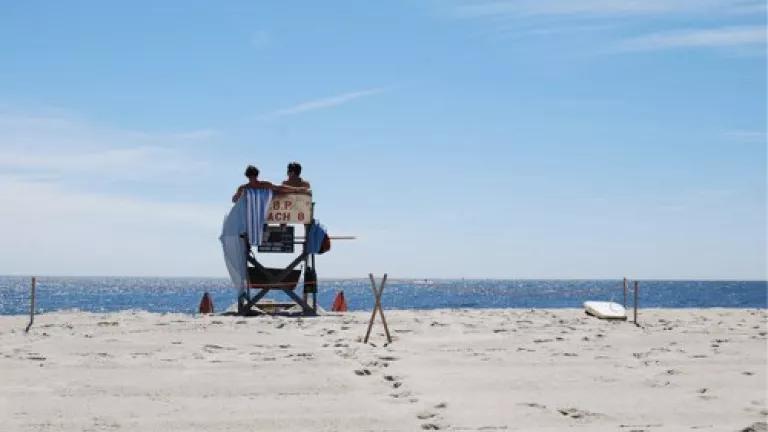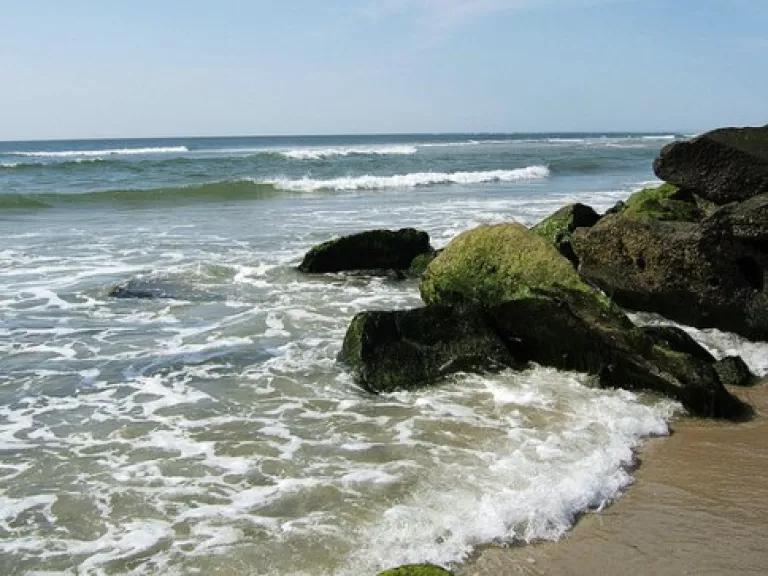
It’s (finally) summertime! And you know what that means: people all over the New York and New Jersey region are grabbing their towels and flip-flops and heading to the states’ beaches for relief from the sweltering heat.
But unfortunately, every year millions of beachgoers nationwide come home feeling sick instead of relaxed and refreshed, thanks to bacteria from human and animal waste floating in the waves. Historically, the largest known sources of that pollution are sewage overflows and stormwater runoff, both of which are carried to the beach when it rains.
Gross, huh?
But don’t let unsafe water spoil your day in the sun—find a cleaner beach! NRDC’s 24th annual report card on America’s beaches—out today!—can help. Testing the Waters: A Guide to Water Quality at Vacation Beaches – collects and analyzes beach water samples (collected by the U.S. Environmental Protection Agency and state officials) from nearly 3,500 beach testing locations nationwide.
Here’s what we found about how the region’s beaches stacked up last year.
NY & NJ SUPERSTAR BEACHES
NRDC awarded “superstar” status to beaches that demonstrated excellent water quality (by consistently having 2 percent or less of their water samples exceed public health violation rates over the last five years).
We gave “superstar” status in this year’s report to 35 beaches across 14 states—one in New York, and a whopping seven in New Jersey (five of which were in Cape May County):
- Ocean County, New Jersey: Broadway (Pt. Pleasant Beach)
- Atlantic County, New Jersey: Washington (Margate) in; 40th St. (Avalon), 40th St. (Sea Isle City), Stone Harbor at 96th St., Upper Township at Webster Rd., and Wildwood Crest
- Nassau County, New York: Long Beach City
Broadway – Pt. Pleasant Beach, NJ
(Photo: Tracy Fay, NJ DEP)
NY & NJ REPEAT OFFENDERS
In contrast to the superstar beaches, sections of 18 U.S. beaches stood out as having persistent contamination problems. Water samples from these “repeat offenders” violated public health standards more than 25 percent of the time for each year from 2009 to 2013. Sigh.
One of these polluted beaches was in New Jersey and three were in New York:
- Ocean County, New Jersey: Beachwood Beach
- Chautauqua County, New York: Main Street Beach
- Chautauqua County, New York: Wright Park
- Monroe County, New York: Ontario Beach

Beachwood Beach, NJ
(Photo: NRDC Media)
BREAKDOWN OF NY & NJ FINDINGS
New York ranked 20th in beach water quality of the 30 states in our report.
Thirteen percent of beachwater samples taken in the state in 2013 violated the federal public health standard used to assess water quality at American beaches—EPA’s newly-created “Beach Action Value.” This is a higher violation rate than the previous year, which had a 9 percent violation rate, using an older and less-protective beach water standard to assess water quality.
Statewide, the specific beaches with the highest percentage of water samples violating health standards were Wright Park East Beach in Chautauqua County (50%), Copiague Harbor beach in Suffolk County (50%), Douglaston Homeowners Association Beach in Queens County (46%), Ontario Beach in Monroe County (40%), and Wright Park West Beach in Chautauqua County (38%).
New York City has both public and private beaches, with the public beaches seeing the vast majority of the city’s beachgoers every year. Generally speaking (with some exceptions), the city’s public beaches tested cleaner than its private beaches.
The public beaches with the cleanest water testing results were Rockaway Beach (all 8 testing locations) in Queens, and Orchard Beach in the Bronx – both of which had a perfect score last year, with zero samples exceeding health standards (although it should be noted that Rockaway Beach had few samples available for analysis). The public beaches with the worst water testing results were Wolfe’s Park Pond (19%) and Cedar Grove (17%), both in Staten Island. Next up were South Beach (8%) and Midland Beach (2%) in Staten Island; and Manhattan Beach (5%) and Coney Island (which ranged from 4-9% at six different testing locations) in Brooklyn.
Two of the city’s private beaches also had perfect water testing scores: the Schuyler Hill Civic Association in the Bronx and one section of Breezy Point (219Th Street) in Queens.
The private beach with the worst testing results by far was Douglaston Homeowners Association in Queens, with 46% of samples exceeding health standards. Other less than stellar private beaches were: West Fordham Street Association (23%), American Turners (22%), White Cross Fishing Club (22%), Trinity Danish Young People's Society (12%), Manhem Beach Club (11%), Morris Yacht And Beach Club (7%), Locust Point Yacht Club (7%), and Danish American Beach Club (7%) in the Bronx; Kingsborough Community College (20%), Gerritsen/Kiddie Beach (15%), Seagate Beach – 38th Street (10%), and Seagate Beach – 42nd Street (3%), in Brooklyn; and Whitestone Booster Civic Association (16%) and Breezy Point - Reid Ave (4%) in Queens.
There are a couple of great ways that New York can work to improve water quality at many of its beaches, so that next year there could be fewer beaches on the list of shame above. In New York City, combined sewer overflows (ick) are a huge problem for beach water quality–to the tune of 30 billion gallons every year. The city has made recent efforts toward absorbing rain fall where it lands heading off sewer overflows (which are triggered after only a tenth of an inch of rain) by incorporating more green infrastructure around the city, such as green roofs, tree boxes on city sidewalks, and increased park space. They’re off to a good start, but there’s still more work to be done for these measures to have a meaningful impact on water quality.
Recently, NRDC also pushed the city to take action to clean up its stormwater runoff pollution problem by legally challenging its stormwater permit (which should limit the amount of contaminated runoff that the city may allow to flow into open water). The permit wasn’t protective enough in ensuring that stormwater discharges comply with water quality standards. The case is now on its way to New York’s Court of Appeals later this year, and we hope it will result in a win for clean beaches, sparkling water and better health for us all.
By the way, this year there's a cool new way to get beach updates: the NYC Department of Health has launched a free texting service to provide beach closings and water testing information to people before they head to the beach.
New Jersey ranked third-best in beach water quality of the 30 states in our report. Looking pretty good, New Jersey!
Statewide, three percent of beachwater samples taken in 2013 violated EPA’s current public health standard. This is a slightly lower violation rate than the previous year, which had a 4 percent violation rate using and the older, less-protective beach water quality standard.
The New Jersey beaches with the highest percentage of water samples violating health standards last year were Berkeley Township at Beachwood Beach West in Ocean County (52%), Neptune Township at Shark River Beach and Yacht in Monmouth County (20%), Berkeley Township at West Beach Avon Road in Ocean County (18%), and Brick Township at Windward Beach in Ocean County (17%).
On a cleaner note, New Jersey also had more than 100 beaches with perfect beachwater quality testing scores in 2013. That’s too many to list here, but among them were popular spots like Bartram Beach (Atlantic City), Illinois Beach (Atlantic City), New Hampshire Avenue Beach (Atlantic City), 9th Street Beach (Avalon), Ocean Avenue Beach (Cape May Point), Sylvania Avenue Beach (Avon), and Lincoln Beach (Seaside Heights).
The state can help add even more beaches to that squeaky-clean list in future years by doing more to address sewage overflows and stormwater runoff in the state as well. For instance, NRDC recently submitted a petition to the the state Department of Environmental Protection calling for a revision to the state’s stormwater permits to meet various Clean Water Act requirements—a move aimed at reducing the amount of contaminated runoff that makes its way to the state’s beaches, using green infrastructure to prevent it from the start.
In addition to state efforts to decrease water pollution and help keep us healthy at the beach, our federal government leaders are working to adopt a critical proposal – the Clean Water Protection Rule proposed by the US EPA and the Army Corps of Engineers – which would restore vital protections for the streams and wetlands that help sustain clean beaches. The EPA and Army Corps of Engineers have not yet finalized and adopted the Rule, which would ensure tributary streams and wetlands are protected from pollution under the Clean Water Act. The proposed rule is important to virtually all communities and beachgoers, and would also impact the hundreds of billions of dollars spent annually on outdoor recreation. The proposed rule, unofficially known as the “Waters of the U.S. Rule,” is open for public comment until October 20 and needs a strong showing of public support to become final. So please stand up for cleaner beaches and healthier water by weighing in on the proposed rule this summer.
Now that you’ve got a little more information about water quality at your local beaches, we hope you can catch a wave with more confidence that you’ll head home feeling healthy. Happy summer, everyone!
For more information:
- New York’s full 2013 testing results: http://nrdc.org/water/oceans/ttw/2014/NY.pdf
- New Jersey’s full 2013 testing results:http://nrdc.org/water/oceans/ttw/2014/NJ.pdf
- Full report & zip code-searchable U.S. beach map: www.nrdc.org/beaches.
